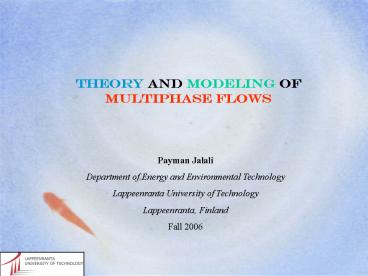Theory and modeling of multiphase flows - PowerPoint PPT Presentation
1 / 30
Title:
Theory and modeling of multiphase flows
Description:
The relative velocity ... The diffusion velocity of a phase is usually ... small particles, the terminal velocity (uniform steady velocity of particle) is ... – PowerPoint PPT presentation
Number of Views:621
Avg rating:3.0/5.0
Title: Theory and modeling of multiphase flows
1
Theory and modeling of multiphase flows
Payman Jalali Department of Energy and
Environmental Technology Lappeenranta University
of Technology Lappeenranta, Finland Fall 2006
2
CFD modeling of multiphase flows Mixture model
The relative velocity Before solving Phase
continuity equation and momentum equation of the
mixture, we need to determine the diffusion
velocity uMk
The diffusion velocity of a phase is usually
caused by the density differences, resulting in
forces on the particles different from those on
the fluid. The additional force is balanced by
the drag force. We can show the physical reason
for the balance equation by a simple example.
Consider 1D equation of motion of a particle in a
fluid under gravitational field g.
3
CFD modeling of multiphase flows Mixture model
Vp and Ap are the volume and cross sectional area
of the particle.uCp is the slip velocity between
particle and continuous fluid. CD is drag
coefficient determined by viscous forces. For
small particles, the terminal velocity (uniform
steady velocity of particle) is reached in a
short time.
uCp (slip velocity) is obtained by equating this
equation to zero. In the present analysis, the
same local equilibrium approximation in the
momentum equations for the dispersed phases are
made.
4
CFD modeling of multiphase flows Mixture model
The drag force represents the additional forces
on a particle due to the velocity relative to the
fluid. For a single rigid spherical particle in a
fluid, the drag force FD due to only viscous
forces is written as
uCp is the averaged relative velocity. CD is the
drag coefficient which is determined via many
different correlations and theories. Reynolds
number defined for particles is an important
parameter to determine drag force.
5
CFD modeling of multiphase flows Mixture model
The standard drag curve (Clift et. al.) and
various simplified correlations in the low
Reynolds number region.
These drag correlations are mostly based on
measurements in homogeneous liquid-solid
suspensions. In dense gas-solid suspensions,
particles tend to form clusters, which strongly
affect the average drag forces.
6
CFD modeling of multiphase flows Mixture model
The balance equation for calculating the relative
velocity can be rigorously derived by combining
the momentum equations for the dispersed phase
and the mixture. After some assumptions and
simplifications we get the following equation for
the slip velocity
The following solution is introduced to this
equation
Where uCp0 is the solution of this equation
without fluctuation terms
7
CFD modeling of multiphase flows Mixture model
Constitutive equations In order to have the field
equations for the mixture model in a form
suitable for applications, they have to be
closed, i.e., constitutive models for the various
terms are required.
8
CFD modeling of multiphase flows Mixture model
Kinematic closure relations Relations between
diffusion velocity and relative velocities, and
between drift velocity and relative velocities
were given earlier
Also, we have this relation for diffusion
velocity that can be also written for drift and
relative velocities
9
CFD modeling of multiphase flows Mixture model
10
CFD modeling of multiphase flows Mixture model
Viscous shear stress
11
CFD modeling of multiphase flows Mixture model
Under some conditions such as regular interface
motions and little phase change effects the
deformation tensor can be simplified as
Then the shear stress of the mixture will be
This equation shows that the mixture viscous
stress is mainly determined by the velocity of
the volume center, jm, rather than that of the
mass center, um. This is why the mixture model is
often called the drift-flux model.
12
CFD modeling of multiphase flows Mixture model
Generalized shear stress (viscous turbulent)
Summary of the model Continuity and momentum
equations for the mixture, the continuity
equation for the dispersed phases and the
algebraic equations for the relative velocities
13
CFD modeling of multiphase flows Mixture model
In turbulent flows
Or, in the analogy to the kinetic gas theory
14
CFD modeling of multiphase flows Mixture model
Implementation of the model
15
CFD modeling of multiphase flows Mixture model
- 1D flows- It has been used in 1D flows in the
form of drift-flux model (gas-liquid and
gas-liquid-solid). - With gravitational and centrifugal forces.
- Turbulent flows.
16
CFD modeling of multiphase flows Mixture model
Given example in FLUENT using mixture model
17
CFD modeling of multiphase flows Mixture model
After reading the geometry
18
CFD modeling of multiphase flows Mixture model
19
CFD modeling of multiphase flows Mixture model
20
CFD modeling of multiphase flows Mixture model
21
CFD modeling of multiphase flows Mixture model
After selecting material from the material panel,
we select phases
22
CFD modeling of multiphase flows Mixture model
23
CFD modeling of multiphase flows Mixture model
24
CFD modeling of multiphase flows Mixture model
25
CFD modeling of multiphase flows Mixture model
26
CFD modeling of multiphase flows Mixture model
27
CFD modeling of multiphase flows Mixture model
Similarly, we set the boundary conditions at the
second velocity inlet boundary condition. Also,
pressure outlet for the third one. Then solve the
problem after initialization and setting solution
parameters.
28
CFD modeling of multiphase flows Mixture model
29
CFD modeling of multiphase flows Mixture model
30
Reference
Manninen M., Taivassalo V., Kallio S., On the
mixture model for multiphase flow, VTT
Publications (1996) FLUENT tutorial 18. Using the
mixture and Eulerian multiphase models.

